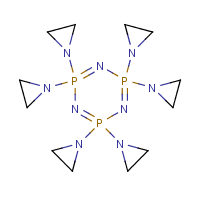Apholate
Agent Name
Apholate
CAS Number
52-46-0
Formula
C12-H24-N9-P3
Major Category
Pesticides

Synonyms
1,3,5,2,4,6-Triazatriphosphorine, 2,2,4,4,6,6-hexakis(1-aziridinyl)-2,2,4,4,6,6-hexahydro-; 1-Aziridinylphosphonitrile trimer; 2,2,4,4,6,6-Hexahydro-2,2,4,4,6,6-hexakis(1-aziridinyl)-1,3,5,2,4,6-triazatriphosphorine; 2,2,4,4,6,6-Hexakis(1-aziridinyl)-2,2,4,4,6,6-hexahydro-1,3,5,2,4,6-triazatriphosphorine; 2,2,4,4,6,6-Hexakis(1-aziridinyl)cyclotriphosphaza-1,3,5-triene; APN; Afolat [Czech]; Aziridine, 1,3,5,2,4,6-triazatriphosphorine derivative; CB 40068; Hexa(1-aziridinyl)-1,3,5-phosphotriazine; Hexa(1-aziridinyl)triphosphotriazine; Hexakis (1-aziridinyl)phosphonitrilate; Hexakis(aziridinyl)phosphotriazine; Hexakis-(1-aziridinyl)phosphonitrile; Myko 63; Olin MO. 2174; PN6; Pholate; SQ 8388; [ChemIDplus]
Category
Other Insecticides
Description
Solid; [Merck Index]
Sources/Uses
Used as an insect chemosterilant (prevents reproduction in certain insects); [HSDB]
Comments
In high-dose animal studies, causes hepatitis and kidney injury; Causes ataxia and paralysis in birds; [RTECS] Mechanism appears to be as alkylating agent on genetic material; Causes marked leukopenia in mammals within 24 hours of injection; Mutagenic in Neurospora crassa; [HSDB]
Biomedical References
Adverse Effects
Neurotoxin
Other CNS neurotoxin
Hepatotoxin
Hepatoxic (a) from occupational exposure (secondary effect) or (b) in animal studies or in humans after ingestion
IARC Carcinogen
Not classifiable
Diseases, Processes, and Activities Linked to This Agent
Processes
Industrial Processes with risk of exposure: